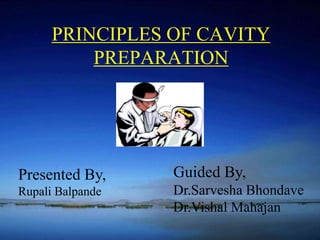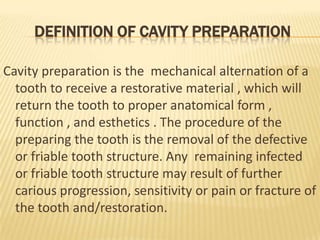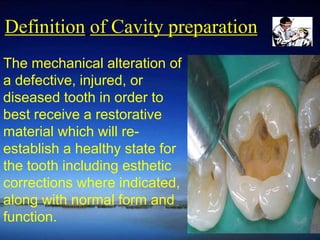Describe the Process and Principles of Cavity Preparation
CAVITYPREPARATION PRINCIPLES PROCEDURES Presentedby CULEEN BARAPON PYRRHIC CANCINO. CAVITY PREPARATION a surgical procedure that removes caries and excises the tooth tissue in order to develop the mortise form that will support and retain the restorative material the orderly operating procedure required to establish in a tooth.
Mi Program About Cavity Design
Describe the process and principles of cavity preparation.

. Click again to see term. Start studying Principles of Cavity Preparation. The proximal part of the cavity that is formed in this process is referred to as the proximal box.
Maintaining the initial depth of 02 to 08 mm into the dentin. -has accessibility in preparing and restoring the tooth. Definition of cavityIs defined as a defect in enamel dentin or cementum resulting from the pathological processes mostly the dental caries.
Steps of cavity preparation 1- Outline form 2- Resistance and Retention form 3- Convenience Form 4- Removal of remaining Caries 5- Finishing of cavity walls 6- Toilet of the cavity. 2- Extend the cavity margins to include all pits and fissures Extension for prevention. Describe tooth-whitening procedures and the role of the dental assistant.
Some basic principles should be considered when preparing a cavity. 1-The outline form It is defined as Shape of the boundaries of the completed cavity External outline form refers to the marginal boundaries Internal outline. Discuss the differences between assisting with an amalgam and with a composite restoration.
Placing protective dental materials lining agents bases desensitizing or bonding agents Term. The degradative pathologic process which causes a defect cavity in enamel or enamel and dentin of a tooth. STEPS Obtain the required outline form.
Learn vocabulary terms and more with flashcards games and other study tools. 5 Finish the enamel wall. No cavity sterilization.
Affected enamel should be removed. Final cavity preparation is. What is ensured during step 5.
The margins of the cavity cannot be properly finished if the outline of the cavity has a jagged form. Learning Objectives Define spell and pronounce the Key Terms. Get started for FREE Continue.
OUTLINE FORM AND INITIAL DEPTH Placing the preparation margins to the place they will occupy in the final tooth preparation except for finishing enamel walls and margins. Dentin which has been severely damaged by the decay process. Caries is a.
Special drilling instruments are used at varying speeds in combination with hand instruments for cavity preparation. The design of the cavity preparation for either a tooth with initial caries or replacement restoration is based on the location of the caries the amount and extent of the caries the amount of lost tooth structure and the restorative material to be used. Learn faster with spaced repetition.
6 Cleanse and medicate the cavity. Removing any enamel diseased dentin or old restorative material or a combination Inserting additional resistance and retention notches grooves and coves. 1- The cavity margins should be placed in sound tooth structure.
The main principles of cavity preparation are to preserve the underlying tooth structure protect the pulp tissue save as much as Enamel or Dentin as possible shape the cavity to achieve maximum resistance and Retention as possible depending on the type of restoration used to help in bearing the mastication forces. Terms in this set 41 Dental Caries. In step 1 why are smooth and flowing curves of the cavity preparation margins crucial.
Describe the process and principles of cavity preparation. 1 Obtain the required resistance form. Done by Carla Malaeb Mariam Masri Zakaria Mazloum Alaa Mourad Mohammad Moukhader 6-Toilet of the Cavity Toileting Technique.
Involves the initial design and extension of the preparations external walls to a limited depth. 1outline form- decides on the design and initial depth of tooth structure. It has a floor.
It is defined as the mechanical and surgical alteration of a defective injured or diseased tooth in order to best receive. Chapter 48 General Dentistry Short answers 1. 2 Obtain the required retention form.
Means placing the cavity margins in the positions they will occupy in the final preparation. Other processes such as abrasion erosion etc. The principles of cavity preparation are divided into two stages each with several steps.
Study principles of cavity preparation. Cavity preparation designs vary according to extent of damage and the type of restorative material to be used. 7- Performing toilet of the cavity.
Flashcards from Caitlin Jenkinss Dundee university class online or in Brainscapes iPhone or Android app. The following factors are intended to help the dentist gain access to the decay or defect and reach sound tooth structure. 1-Phenol Pulp necrosis 2-Silver 3-Alcohol 4-Hot air blast 5-Hydrogen peroxide 6-Water spray FOR WHAT REASONS WE DO THE TOILETING.
Can also cause such defectsCavity preparation. Cavity preparation is the process of removing diseased tooth structure while leaving a limited amount of healthy tooth structure for the tooth to maintain a restoration. The dentist follows these steps in an exact order so that ideal results are achieved.
2resistance form- determines the primary shape and placement of cavity walls. 3 retention form- determines where to place retention to help securing restoration. What is step 5.
4 Remove any remaining carious dentin. 3 Obtain the required convenience form. Finish The Enamel Walls.
Describe the procedure of composite veneers. Outline form defines the external boundaries of the preparations. Should be done 6.

Principles Of Cavity Preparation By Dr Rupali



No comments for "Describe the Process and Principles of Cavity Preparation"
Post a Comment